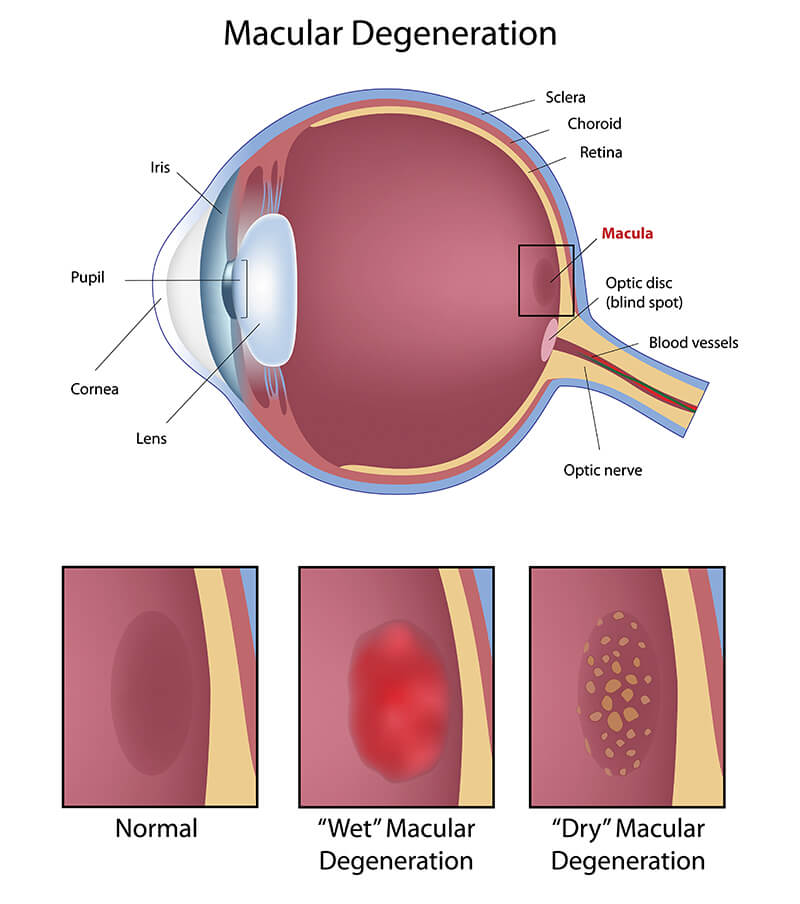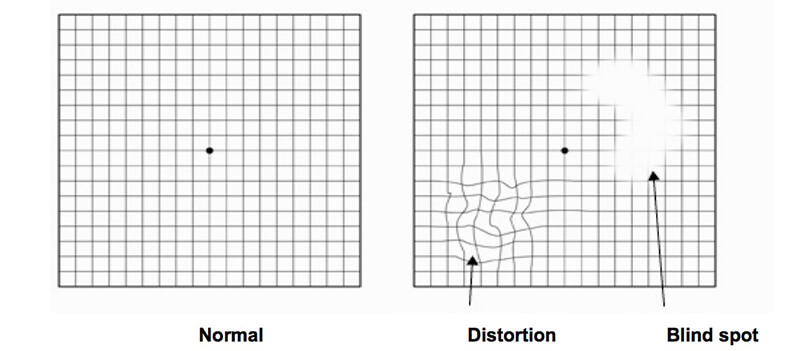Age-Related Macular Degeneration is a disease that affects the retina in the back of the adult eye.
- The retina contains the cells that function by receiving visual information from the environment.
- The macula is in the center of the retina and contains the cells responsible for our central vision.
- Damage to the macula causes patients to see less in the center of their vision.

Risk Factors
- Age over 60
- History of smoking
- Caucasians have a higher risk than African-Americans or Latinos.
- Family history or genetic factors
Two Types of Macular Degeneration
Dry Macular Degeneration
- More common
- Drusen (small yellow spots) are present
- Thinning of the layer beneath the retina
- Can lead to progressive decreased vision
- May be mild in some patients
- Early Symptom: Difficulty reading
Wet Macular Degeneration
- Can be aggressive
- Growth of abnormal blood cells underneath the retina
- Blood cells may bleed or leak
- Causes loss to the center of the vision
- Complete blindness very rare
- Early symptoms:
- Visual distortion –objects look crooked or bent
- Center of vision is dark
An Amsler Grid is a hand-held chart with a grid pattern which is useful to detect early visual distortion in wet macular degeneration.

How is it diagnosed?
- A complete eye examination using drops to dilate the pupil.
- Further testing such as optical coherence tomography (OCT).
- Fluorescein angiography to identify abnormal blood vessels in wet AMD. This test is performed by injecting a vegetable dye into an arm vein while taking photographs of the retina.
Treatment
An ophthalmologist who is experienced in interpreting the results of sophisticated examination and testing should recommend the best course of treatment for each patient.
- Monitoring: Most cases of macular degeneration do not need to be treated, and patients maintain good vision.
- Laser treatment can benefit a small percentage of patients who develop wet AMD.
- Intra-vitreal injections – The injection of anti-VEGF (vascular endothelial growth factor) drugs into the vitreous cavity can be a highly effective treatment for wet AMD. The drugs (ranibizumab, bevacizumab and aflibercept) stop the growth of new blood vessels in the eye. This is done as an office procedure. Patients require periodic monitoring of their disease to reevaluate for additional treatments with the anti-VEGF agents. Most patients require a series of injections.
Prevention
In a large clinical trial throughout the US, called the AREDS2 study, daily use of a combination of vitamin A, C and E demonstrated a benefit for certain forms of dry age-related macular degeneration. Patients were less likely to develop wet macular degeneration.
Most patients with moderate numbers of drusen can begin vitamin supplementation to reduce the potential risk of developing wet macular degeneration. An ophthalmologist should evaluate your medical history and determine whether vitamin supplementation is right for you.
The earlier that wet macular degeneration is detected, the greater the possibility that a laser treatment may be effective in maintaining vision. Therefore, patients are encouraged to use an amsler grid regularly to monitor changes, and to see their ophthalmologist if they have any changes or symptoms.
